Fishes are finned aquatic vertebrates, found abundantly in almost all bodies of water. As the first vertebrates (backboned animals) to evolve, they lack limbs. Fish-like animals first appeared all the way back in the Cambrian Period more than 500 million years ago. The strange jawless fishes that lived during the next hundred million years, however, would not look very familiar to us. In the “Age of Fishes” (Devonian period), however, several kinds of fish appeared that gave rise to much of today’s fish diversity. Some of their modern-day descendants appear virtually unchanged from their fossil ancestors - examples include sharks and coelacanths. Devonian fishes, specifically the lobe-finned fish group, also gave rise to all tetrapods - vertebrates with four limbs.

Perhaps one of the best known examples of “living fossils,” coelacanths are more closely related to land-living vertebrates than to ray-finned fish. The discovery of living coelacanths has been called one of the most famous and significant in twentieth century biology.
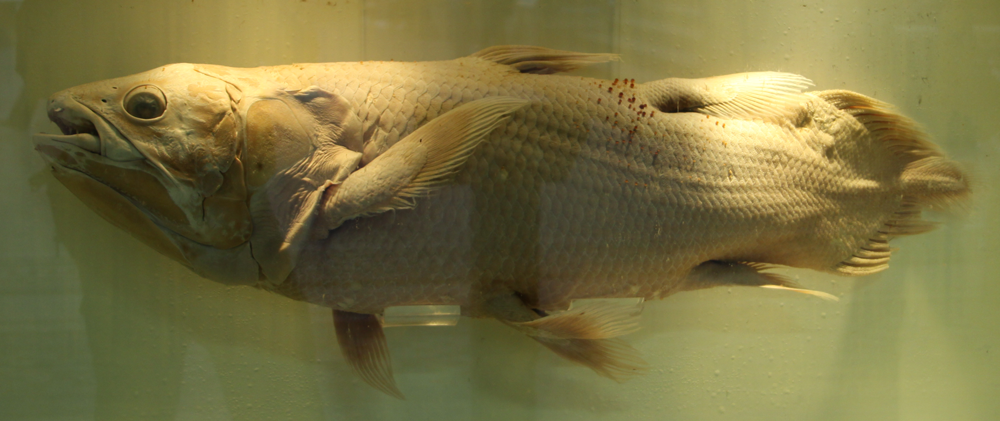
Preserved specimen of the modern coelacanth Latimeria chalumnae on display at the Natural History Museum, London. Photograph by Jonathan R. Hendricks.
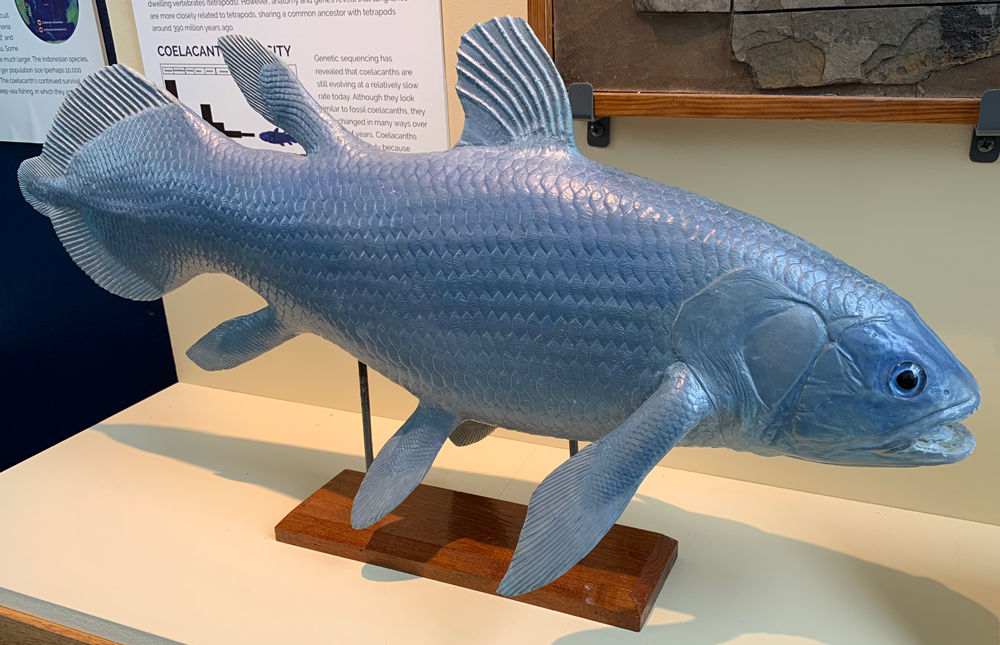
A teaching model of the modern coelacanth Latimeria chalumnae. Photograph by Jonathan R. Hendricks.
Approximately 80 species of fossil coelacanth have been described, from the Middle Devonian to the Late Cretaceous (about 360 to 70 million years ago). They were thought to have become extinct at the end of the Cretaceous, until they were found alive in 1938.
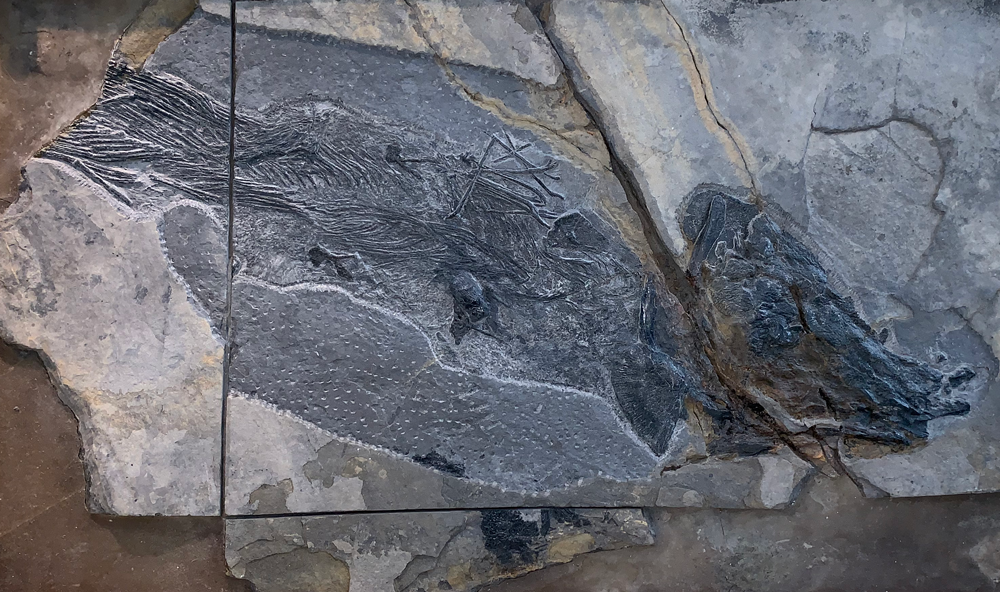
Fossil specimen of the coelacanth Diplurus longicaudatus from the Jurassic of Connecticut (collections of the Paleontological Research Institution).

Coelacanth diversity over geologic time.
Modern coelacanths live in caves and rocky outcrops hundreds of feet below the ocean’s surface. They are larger than most of their fossil ancestors, reaching over 6 feet long and weighing 200 pounds. Scientists estimate they can live up to 60 years or more. They are “passive drift feeders,” slowly drifting with currents and using only minimal self-propulsion, eating whatever prey they encounter.
"Finding the Coelacanth | DinoFish" by Nat Geo WILD.
Paired lobed fins, extend away from the body like arms and legs, and move in an alternating pattern. Due to these fins and other features, coelacanths were once thought to be the most recent shared ancestor between other bony fishes and land-dwelling vertebrates (tetrapods). However, anatomy and genes reveal that lungfishes are more closely related to tetrapods, sharing a common ancestor with tetrapods around 390 million years ago.
Genetic sequencing has revealed that coelacanths are still evolving at a relatively slow rate today. Although they look similar to fossil coelacanths, they have changed in many ways over millions of years. Coelacanths may evolve slowly because they have few predators, and live in the deep ocean where conditions remain stable.
Lost & Found
The first modern coelacanth was discovered in December 1938 on the east coast of South Africa. It immediately made headlines around the world as a “fish from the age of dinosaurs.” A second specimen was found in 1952, in the Comoro Islands between eastern Africa and Madagascar. In 1998, a second species was discovered on the other side of the Indian Ocean, off Sulawesi, Indonesia.
More than 300 specimens have been caught or observed since the modern coelacanth’s discovery. Although several individuals had been observed alive for short periods after being line-caught, it was not until 1987 that coelacanths were observed alive in their natural habitat.
Conservation Connection
Because so little is understood about the two living coelacanth species, their conservation status is difficult to know. The Western Indian Ocean species, Latimeria chalumnae, is classified as Critically “endangered” and its population may be fewer than 500 individuals. Some scientists, however, think its population may be much larger. The Indonesian species, Latimeria menadoensis, has a significantly larger population size (perhaps 10,000 individuals), and is considered “vulnerable”. The coelacanth’s continued survival may be most threatened by commercial deep-sea fishing, in which they are caught unintentionally as bycatch.

Gars are primitive fishes that first appeared in the Late Jurassic, around 157 million years ago. Gars are lurking ambush predators, and some grow to more than 9 feet in length.
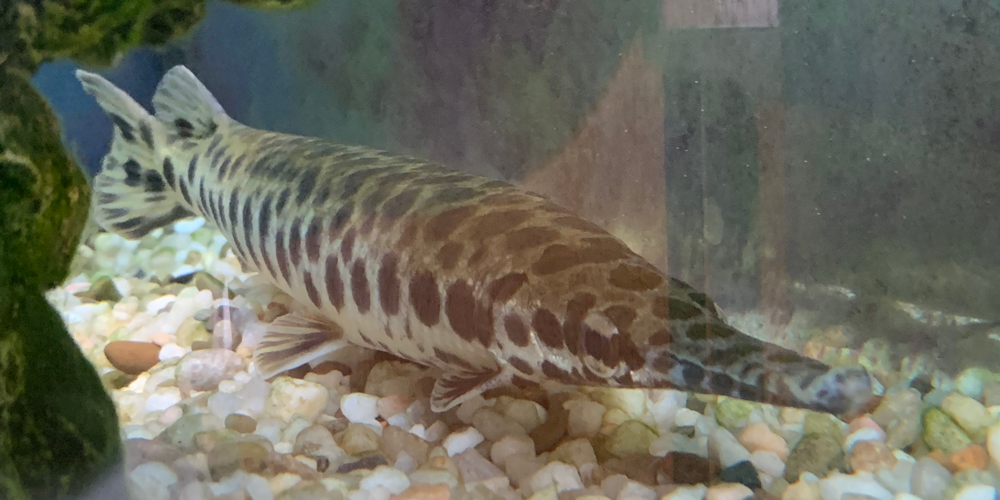
A live spotted gar (Lepisosteus oculatus) in an aquarium exhibit. This gar is appropriately named "Spot."
Gars are called living fossils due to their primitive anatomy, including heavy diamond-shaped scales, vertebrae extending into the tail, and an intestine similar to that of sharks. Gar scales differ from the thin, flexible scales of most other living fishes, and are covered by a shiny enamel-like substance called ganoin. The scales’ thickness makes them nearly impenetrable, providing excellent protection from predators. They also share unique features, like an elongated snout, which may be narrow or broad depending on the species’ prey preferences. Although gars have gills, their swim bladder can also function as a lung. This adaptation allows them to breathe air, and gars can live in water that would suffocate most other fishes.
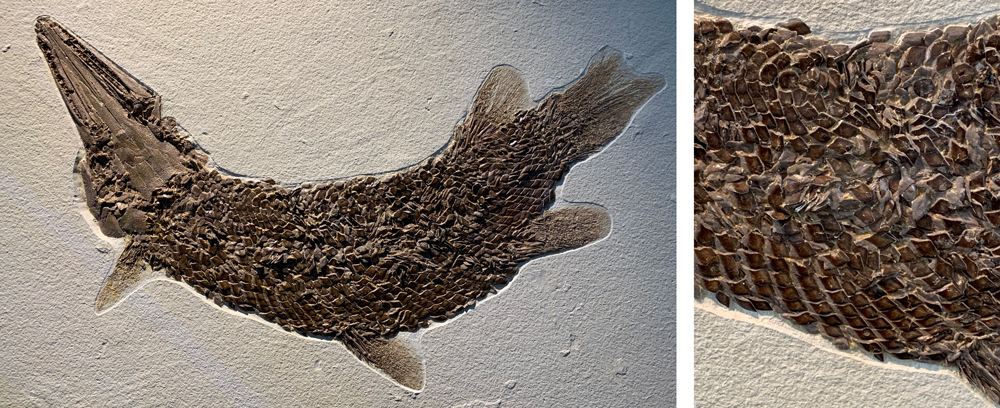
Fossil gar Lepisosteus simplex from the Eocene Green River Formation of Wyoming. Right image shows close-up view of diamond-shaped scales, common to both modern and ancient gars. Specimen is part of the research collection of the Paleontological Research Institution, Ithaca, New York.
3D scan of the internal bones of the spotted gar Lepisosteus oculatus. Note how the gar's vertebrae extend into its tail region. Scan produced by the Plant Cytogenetics Laboratory / Technical Section of the National Institute of Genetics in Japan.
Amazing Adaptation: Catching Prey
The spotted gar has a very strong snout that is full of sharp teeth. Gar comes from the word "spear" in the Anglo Saxon language. The snouts have shown to be very useful in catching prey. The way these fish move when hunting their prey is the very opposite from how they move most of the time. When on the prowl, these gar move very fast and swift. Any other time they are very slow and have an easy going pace.
"
There are seven living species of gar, all found in the Western Hemisphere. Their range spans rivers, large streams, and lakes from Costa Rica and Cuba to Texas and eastern North America, as far north as Lake Champlain. Some species may even venture into marine waters, but are unable to cross large stretches of ocean. Gar fossils are known from a much wider geographic range, including Europe, India, South America, and Africa. The earliest gars occur in the Early Cretaceous fossil record (about 100 million years ago), but the most famous gar fossils in the United States come from the Eocene Green River Formation in southwestern Wyoming, one of which is shown above.
Conservation Connection
The alligator gar, the largest gar species in the US, was long considered a “trash fish” or “nuisance species.” It was targeted for eradication by state and federal authorities, and populations were eliminated from much of their historic range in the Mississippi River Valley. Over time, alligator gars were afforded some state and federal protection. They are also protected under the Lacey Act, a federal law that makes it illegal to transport certain species of fish across state lines. Alligator gars are now being raised in captivity for restocking and other purposes.
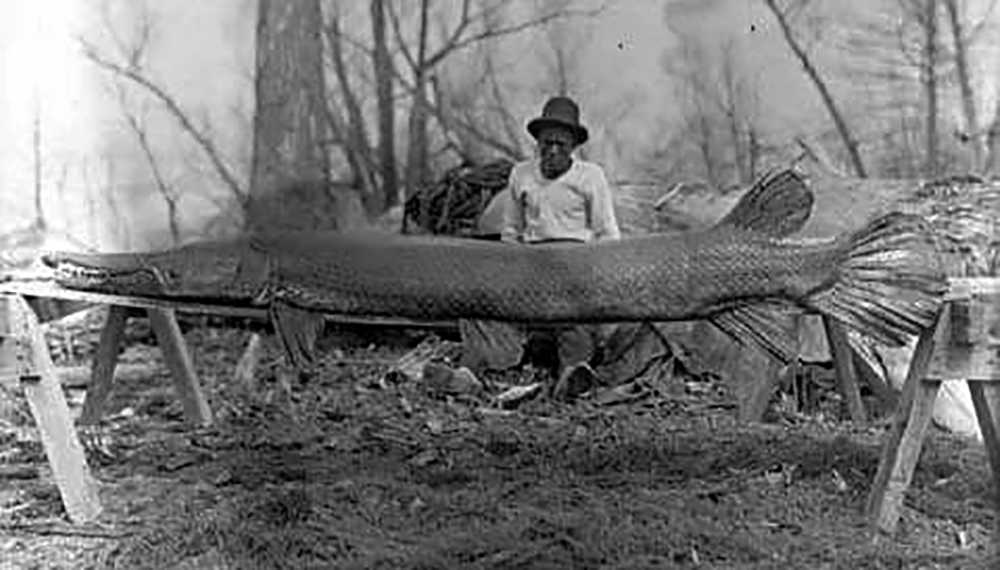
An exceptionally large alligator gar (Atractosteus spatula), purportedly 10 feet in length, from Moon Lake, Mississippi. Photograph by D. Franklin is from 1910 (Wikimedia Commons; public domain).

Sturgeons (and their close relatives, the paddlefishes) are among the most ancient ray-finned fishes. They are visibly different from all other fishes, with an elongated body protected by five rows of armored scales, called scutes. There are 27 living species of sturgeon belonging to the family Acipenseridae, a group that dates back to the Triassic Period (245-208 million years ago).
A juvenile lake sturgeon (Acipenser fulvescens) in an aquarium exhibit.
Sturgeons have long life spans and reproduce slowly. They can tolerate a wide range of temperature and salinity, and are well protected from predators thanks to their size and bony armor. Their asymmetrical tail is similar to that of sharks. Several species can grow quite large, ranging up to 12 feet long. Sturgeons have more genetic and size variation that many other fish groups. Within some species, the body shape and skeleton can be highly variable, indicating that evolution is still occurring.
Sturgeons are bottom-feeders with varied diets. They spend most of their lives feeding in river deltas and estuaries, although they migrate upstream to spawn. Some species live only in freshwater, while others inhabit coastal marine environments and venture into the open ocean.
Amazing Adaptation: Catching Prey
The name sturgeon in several European languages means "the stirrer," from the way the fish rummages among the mud for food. Lake sturgeon find their food largely by touch, using their sensitive barbels. As they cruise over the bottom, the sensitivity of the fleshy whiskers trailing in the mud makes up, to some extent, for the fish's poor eye sight.
Conservation Connection
All living sturgeons and paddlefishes are at some risk of extinction, due to human uses of their spawning rivers and feeding habitats. Several species of sturgeon are harvested for their eggs (roe), which are processed into caviar.
The lake sturgeon (Acipenser fulvescens) is the largest and longest-living freshwater fish in New York State, growing up to 5 feet long, weighing up to 80 pounds, and living up to 150 years. They were historically abundant in the Great Lakes and surrounding waters until the early twentieth century, when overharvest and habitat degradation sharply reduced their populations. Lake sturgeon were not native to Cayuga Lake, but probably entered via the Erie Canal in the early nineteenth century. Fishing reduced the population close to zero by the late twentieth century. Since 1995, New York State has stocked lake sturgeon into Cayuga Lake to re-establish a breeding population. In spring 2017, lake sturgeon were observed spawning in Fall Creek in Ithaca.
Contents: Introduction | Microbialites | Plants | Echinoderms | Fishes | Reptiles | Opossum | Brachiopods | Mollusks | Horseshoe Crabs | Insects & Arachnids



